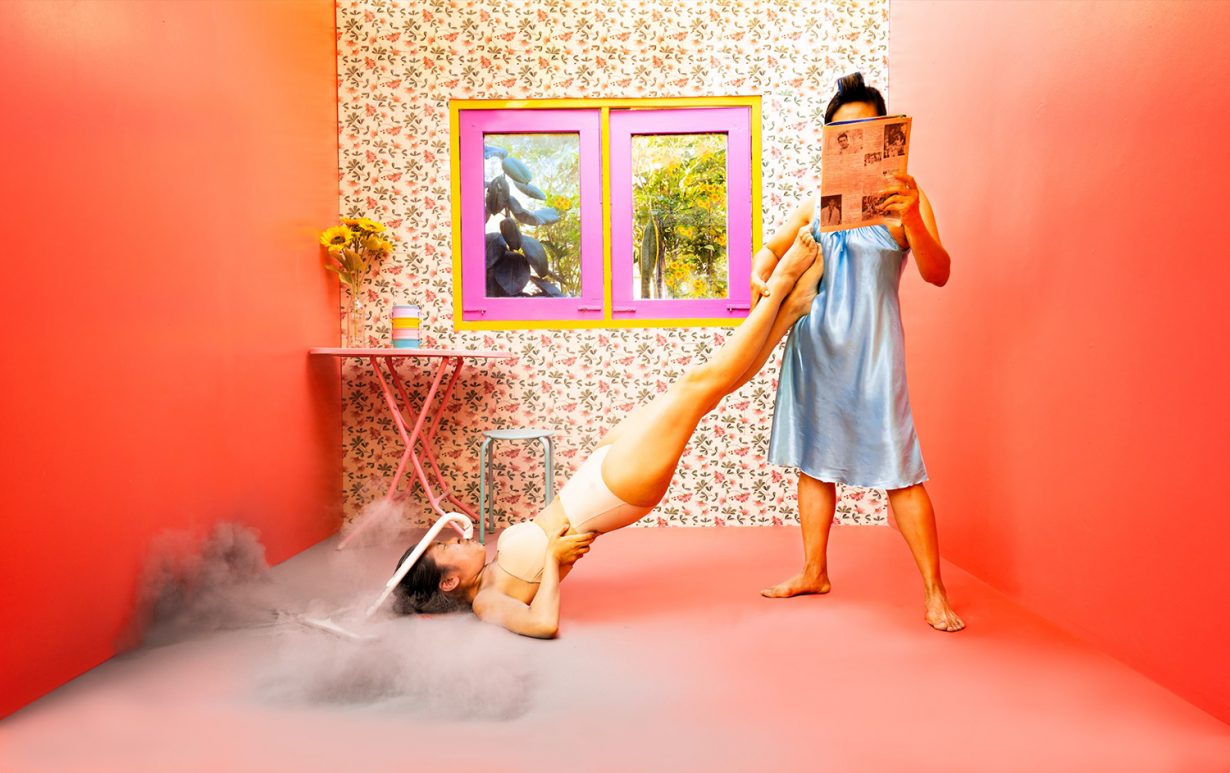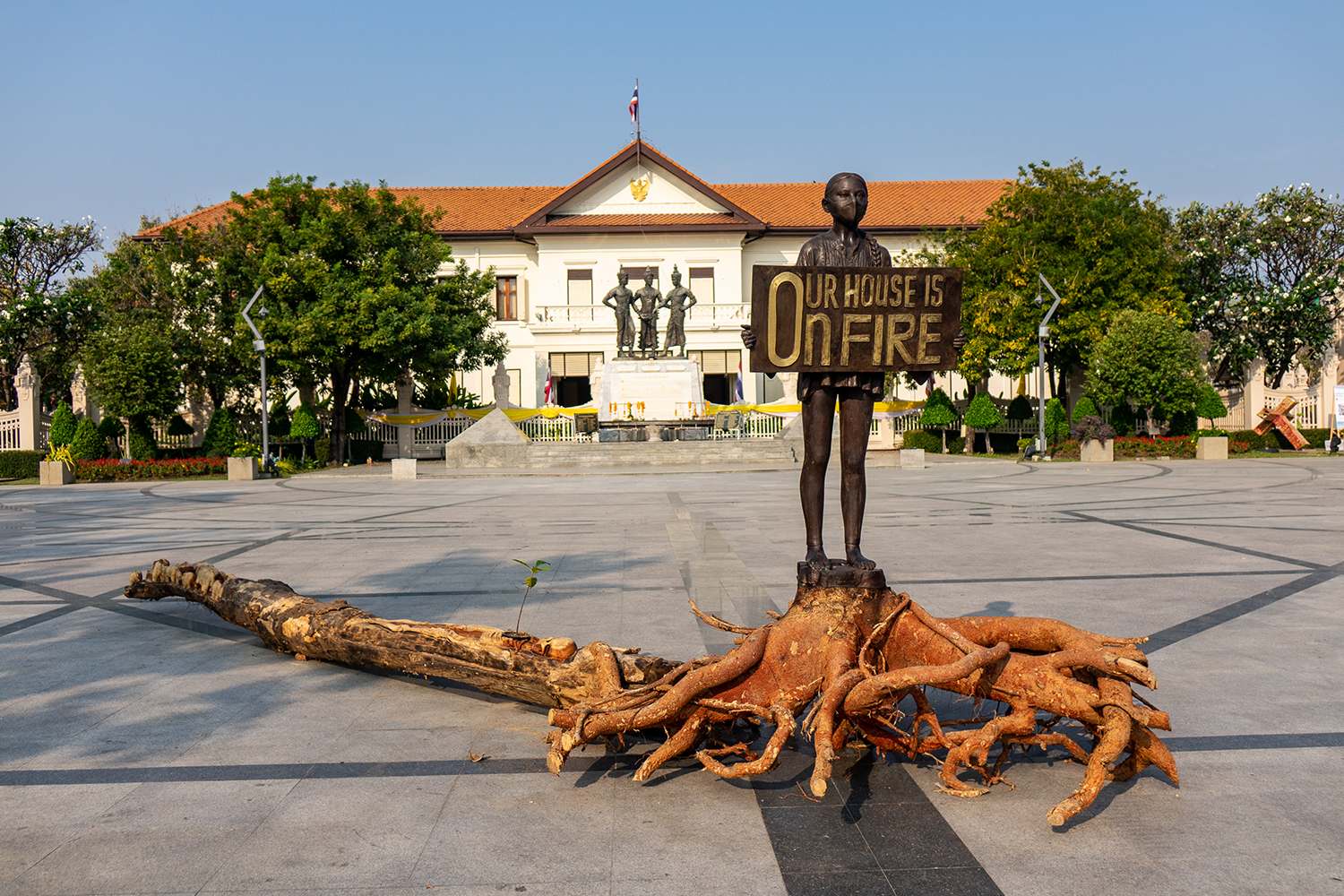Art for Air in Chiang Mai took aim at the air pollution which has turned a charmed city into a cautionary tale for Anthropocene-era textbooks
‘Chiang Mai is a disaster zone,’ reads a five-metre-high banner by Piyarat Piyapongwiwat, hung from a courtyard balustrade at the Chiang Mai City Arts & Cultural Centre, beside the wood furniture and parasols where tourists – the few that remain – enjoy refreshments on hot, sticky afternoons. This simple work can be forgiven for seeming abrupt and melodramatic – Piyapongwiwat has a point. Well before the pandemic presented its own unique threat to our respiratory tracts, the citizens of Chiang Mai were already blighted by one of the invisible byproducts of its age-old traditions and runaway success: PM2.5 particles. Recent years have seen the seasonal smoke from fires lit by farmers and hilltribes, as they look to clear crop stubble or fallen leaves, being joined by ultrafine particulate matter from cars, factories, construction, who knows what. As a result, a thick pall of smog blankets the province for much of the year; whirring air purifiers have become a fixture in many homes; a destination long seen as fortifying on account of its thick mountain terrain and ‘Lanna’ culture now consistently ranks among the world’s most polluted places.
Who is to blame for turning a charmed city into a cautionary tale destined for the Anthropocene-age textbooks? An animation by the Breathe Council – a young, civil-society clean air movement that funded this awareness-raising group exhibition – points the finger at everyone, but also throws up a shocker of a statistic: 80–90 percent of the smoke is caused by controlled fires in conserved forests and national reserves. Perhaps that is why a good proportion of Art for Air’s 80-plus artworks are dotted around the city’s iconic Three Kings Monument, right on the doorstep of municipal government: the organisers clearly want them, even more than the people, to pull their fingers out.

“Artists shouldn’t have to create art for clean air. We pay our taxes!”, an exasperated curator told me when I flew up from Bangkok – yes, I’m to blame, too – in late February. Many works give dramatic vent to such commonly encountered admixtures of anger, confusion and frustration. In a public square, steps from the unperturbed statues of ancient kings, director Kamin Lertchaiprasert has placed a rotten tree root, sections of its bark carved to reveal a family of elephants and a human skeleton. A tree shoot sprouts from the skeleton, beside a charred lifesize sculpture of a masked Greta Thunberg – an inspiration, naturally – holding up a sign bearing her slogan: ‘Our house is on fire’. Plonked nearby are many other crude yet effective works, such as Wannawit Patteep’s giant sculpture of a furry palm civet that became a cause célèbre when, in April last year, it was found blinded and burnt, spluttering from smoke inhalation, on a mountain road. The indignation continues at every turn: in flags emblazoned with skull-faced corn ears; in four performance videos by Kawita Vatanajyankur, in which she plays the role of dust-clogged human hoover with gusto; and, at Dreamspace Gallery, in a glut of popping street art starring everything from firefighting birds to soot-stained babies.

It would be easy to be sniffy about such one-dimensional fare – visceral art that signposts the ‘dead air’ problem but says little about the structural weaknesses (the city’s neoliberal expansion? The premodern order underpinning it? A bit of both?) behind it – but then I don’t live in a city where the political has engulfed the personal so completely, where the farming industry and vested interests have trumped public health to the extent that I must consider leaving it for good, or failing that, face early death. Moreover, nuances are teased out elsewhere in this citywide, 12-venue show, courtesy of the many research-based works flecked throughout. Piyapongwiwat’s banner references the contentiousness of the official ‘disaster zone’ designation (under which government departments gain access to deep emergency coffers, yet businesses, especially those tied to tourism, suffer). Nearby, Rirkrit Tiravanija’s parabolic solar cooking stove, used to feed the public during the opening-weekend festivities, invokes the broad banner yang yuen (sustainability), one of many actionable ways to reduce the burning. At the Chiang Mai Historical Centre, Sutthirat Supaparinya’s Light Me Softly (2020), a photo series comprising night shots of urban Chiang Mai, floodlit country roads and blazing forest fires, suggests the blame belongs to everyone, city slickers as well as country folk.

Sanitas Pradittasnee’s installation Turning the Cycle (2021) – displayed at the hangarlike Jing Jai Warehouse, alongside impressionistic works by Araya Rasdjarmrearnsook and Apichatpong Weerasethakul, among notable others – broaches the ongoing dialogue between hilltribes and technocrats. Resembling a campfire, this circular curtain of white, black, orange and red thread blends fire-management data with the weaving techniques of the Karen tribe and hints at rigid power structures with a circle of stone millet seeds, neatly arranged in concentric patterns on the floor. And of the videoworks, the immediacy and pessimism of Pen-ek Ratanaruang’s contribution, at Gallery Seescape, stands out: a silhouetted girl nonchalantly plays with her phone throughout, as wisps of smoke slowly clog the screen, and sweet birdsong is replaced by cacophonous sirens, then hollering protesters.
Money well spent? Clearly, scaling workable solutions to the smog problem and achieving buy-in at all levels is what’s really needed at this stage. But while Art for Air may only trace the contours of an intractable problem, and for the benefit of an audience who already live and breathe that problem, its inclusivity and conviviality also arguably set out the right ethos. Without wishing to sound naively optimistic, a multipronged and multistakeholder approach that puts ego and status aside, that draws upon hard science, local wisdom, lived experience and no small amount of outrage – as its organisers and ragtag lineup of Thai artists have done – is surely Chiang Mai’s best hope for averting disaster?
Art for Air, various venues, Chiang Mai, 14 February – 30 April 2021
